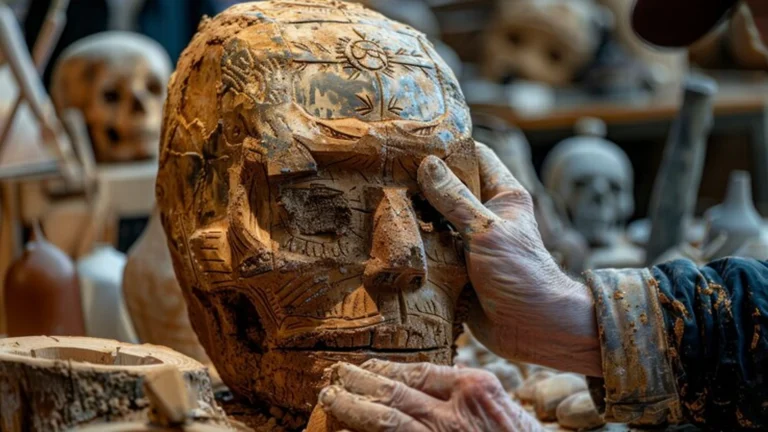Ancient art offers a unique glimpse into the cultures, beliefs, and daily lives of early civilizations, with each piece revealing something significant about the past. From intricate sculptures to monumental architecture, ancient art serves not only as aesthetic achievements but also as historical documents that help us understand how people lived, worshiped, and expressed themselves thousands of years ago. But what exactly defines ancient art? What are its elements, and what examples remain today? Let’s dive into the world of ancient art and address some of the most frequently asked questions about this fascinating field.
What is Ancient Art Called?
Ancient art is a broad term used to refer to the art and artifacts created by ancient civilizations. This includes the visual and decorative arts produced in the early societies of Mesopotamia, Egypt, Greece, Rome, China, the Indus Valley, the Americas, and more. Ancient art isn’t defined by a single name but rather is categorized by the culture or civilization that produced it, such as Egyptian art, Greek art, or Roman art. Each civilization developed its own distinctive styles and motifs that reflected its religious, political, and social values.
What is the Summary of Ancient Art?
In summary, ancient art encompasses the visual expressions of early human societies and includes paintings, sculptures, pottery, and architecture. These works were often closely tied to religious practices, cultural rituals, and daily life. Many ancient artworks also served as symbolic representations of power, with rulers and deities frequently depicted in elaborate sculptures and paintings. Ancient art is marked by realism, symbolism, and a focus on the divine or mythological, with each civilization developing a unique artistic style that reflected its beliefs and values.
How Old is Ancient Art?
Ancient art dates back to some of the earliest known human societies and spans thousands of years, typically considered to begin around 30,000 BCE with prehistoric art, such as cave paintings in France and Spain. The term “ancient art” more specifically applies to art created by established civilizations, such as those of Egypt and Mesopotamia, which emerged around 3500 BCE. Art from these ancient cultures has survived for thousands of years, preserved in the form of sculptures, pottery, and architectural remains, giving us an enduring link to humanity’s earliest civilizations.
What Are the Elements of Ancient Art?
The elements of ancient art often include symbolism, realism, and materials tied to the culture’s resources and technology. Key characteristics of ancient art include:
- Religious Symbolism: Art was often intertwined with religious practices, depicting gods, goddesses, and mythological scenes.
- Use of Natural Materials: Artists used resources available in their environments, like stone, clay, metals, and minerals for pigments.
- Detail and Craftsmanship: Ancient art often displays intricate detail, whether in stone carvings, jewelry, or pottery, indicating a high level of skill.
- Stylized Human Forms: While realistic, ancient art often stylizes figures, emphasizing idealized features or symbolic representations of status, power, or divinity.
Each civilization had its unique approach, with Egyptian art favoring symmetry and order, Greek art emphasizing human perfection, and Mesopotamian art focusing on hierarchical scale (depicting important figures as larger).
What Are the 4 Ancient Arts?
While there isn’t a strict classification of “four ancient arts,” we often think of art in ancient civilizations through these four key forms:
- Sculpture: Ranging from small figurines to colossal statues, sculpture was essential in depicting gods, kings, and cultural heroes.
- Architecture: Ancient civilizations constructed temples, pyramids, ziggurats, and other structures to honor their deities and rulers.
- Pottery and Ceramics: Pottery was used for both everyday purposes and ceremonial functions, often decorated with cultural motifs.
- Painting and Murals: Wall paintings and frescoes were common, especially in Egyptian tombs and Greek palaces, often illustrating mythology or daily life.
These categories cover a broad spectrum of ancient artistic expressions and serve as invaluable resources for understanding ancient cultures.
What is an Example of Ancient Art?
One iconic example of ancient art is the Great Pyramid of Giza in Egypt. Built around 2580–2560 BCE, this ancient marvel is a testament to the architectural skills and religious beliefs of the ancient Egyptians, who believed in an afterlife and constructed elaborate tombs for their pharaohs. Another notable example is the Venus of Willendorf, a small Paleolithic sculpture dating to around 25,000 BCE. This figurine represents fertility and femininity, providing insight into early human beliefs about life and nature.
Other famous examples include:
- The Parthenon (Greece): A temple dedicated to Athena, showcasing the artistry of ancient Greek architecture and sculpture.
- Terracotta Army (China): Thousands of life-sized clay soldiers buried with China’s first emperor, Qin Shi Huang, illustrating ancient Chinese burial customs and artistic skill.
- Stonehenge (England): A prehistoric monument that continues to intrigue archaeologists and historians for its mysterious origins and astronomical alignment.
Why Ancient Art Matters Today
Ancient art offers more than just aesthetic appreciation—it provides a record of our shared human past, reflecting the values, beliefs, and creativity of early societies. Many elements from ancient art, such as symbolism, craftsmanship, and the exploration of human experience, continue to influence modern art and culture. By studying ancient art, we connect with the foundations of art history and gain insight into how different civilizations sought to understand their world.
In a way, ancient art is timeless, bridging the past and present, offering both inspiration and a sense of continuity that links us to the origins of human creativity.
